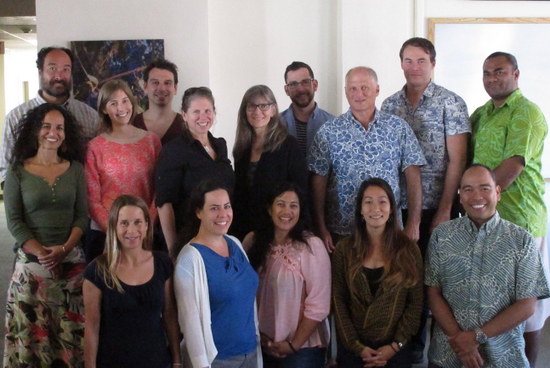SNAPP: Developing guidelines for and assessing relationships among biocultural indicators to improve long-term resilience of Pacific social and ecological communities
Project Description
Biodiversity and food- and water-security throughout the Pacific will be negatively impacted by climate change. Climate change, in combination with local stessors, will lead to the exploitation of resources, habitat transformation, and the spread of invasive species in the Pacific. Enduring these pressures will require practices and policies that best foster resilient and adaptive communities to be adopted. Unfortunately, existing research largely lacks consideration of the factors most critical to Pacific Island community resilience: the linkages between biological, social and cultural connections, otherwise known as biocultural indicators. What constitutes a biocultural indicator? A standard biological indicator is the population size of threatened fish species, whereas a standard social/cultural indicator might be the relative abundance of culturally important fish species. Biocultural resilience indicators integrate the feedbacks between people and ecosystems and could look like: Population size of slow-growing (or fast-growing) fish species that has importance to local community in terms of customary beliefs, traditions, or uses. In order to improve long-term community resilience to these changes, this Working Group will develop a biocultural approach to community planning and monitoring that incorporates the intimate connections of Pacific peoples with the land and sea. On a local scale, the Working Group’s results will enhance resilience thinking in existing management plans in Fiji, Hawai’i, and Solomon Islands. Their analysis will consist of three phases: 1) Identifying appropriate biocultural indicators and how they can be measured 2)Developing methods to scale indicators from local to global levels 3)Determining the relationships between pressures, the ‘biocultural state’, benefits, and management responses in Pacific Island communities.

Principal Investigator(s)
Project Dates
Start: December 1, 2015
End: November 30, 2018
completed
Participants
- Jonh Aini
- Simon Albert
- University of Queensland
- Pelika Andrade Bertelman
- Sophie Caillon
- Centre National de la Recherche Scientifique (CNRS)
- Jennifer E. Caselle
- University of California, Santa Barbara
- Joachim Claudet
- Centre National de la Recherche Scientifique (CNRS)
- Rachel Dacks
- University of Hawaii, Manoa
- Emily S. Darling
- University of North Carolina, Chapel Hill
- Presley Dovo
- Pauline Fabre
- Emily Fielding
- Chris Filardi
- American Museum of Natural History
- LeeAnne French
- University of California, Santa Barbara
- Alan M. Friedlander
- University of Hawaii, M?noa
- Samuel Gon
- Hugh Govan
- Steven A. Gray
- University of Hawaii, Manoa
- Craig Groves
- The Nature Conservancy
- Elise Huffer
- Stacy D. Jupiter
- Wildlife Conservation Society
- Sol Kaho`ohalahala
- Taholo Kami
- Hi'ilei Kawelo
- Peter Kenilorea
- Natalie Kurashima
- Albert C. Kwatelae
- Naia Lewis
- Lisa A Mandle
- Stanford University
- Alexander Mawyer
- University of Hawaii, Manoa
- Joe McCarter
- American Museum of Natural History
- Manuel Mejia
- The Nature Conservancy
- Kanoe'ulalani Morishige
- University of Hawaii, Mānoa
- Winifereti Nainoca
- United Nations Development Programme
- Lihla Noori
- Hawaii Conservation Alliance (HCA)
- John E. Parks
- Marine Management Solutions
- Puaʻala Pascua
- University of Hawaii, Manoa
- Mere Ratunabuabua
- Paul Roughan
- Etika Rupeni
- Myknee Q. Sirikolo
- Eleanor J. Sterling
- American Museum of Natural History
- Jaimie Tanguay
- Vanuatu National Statistics Office
- Alifereti Tawake
- Anteneh T Tesfaw
- Conservation International
- Randy Thaman
- Tamara Ticktin
- University of Hawaii, Manoa
- Eleni Tokaduadua
- Ron Vave
- University of Hawaii, Manoa
- Veronica Wase
- City of Majuro
- Kawika B. Winter
- Supin Wongbusarakum
- National Oceanic and Atmospheric Administration (NOAA)
Products
-
Journal Article / 2021
Assessing human well- being constructs with environmental and equity aspects: A review of the landscape
-
Journal Article / 2018
Biocultural Restoration of Traditional Agriculture: Cultural, Environmental, and Economic Outcomes of Loâi Kalo Restoration in Heâeia, Oâahu
-
Journal Article / 2019
Developing biocultural indicators for resource management
-
Journal Article / 2018
Linking Land and Sea through Collaborative Research to Inform Contemporary applications of Traditional Resource Management in Hawaii
-
Journal Article / 2019
Place-based management can reduce human impacts on coral reefs in a changing climate
-
Journal Article / 2018
Effective Biodiversity Conservation Requires Dynamic, Pluralistic, Partnership-Based Approaches
-
Journal Article / 2018
Protected land: Many factors shape success
-
Journal Article / 2019
Ecosystem services for human health in Oceania
-
Journal Article / 2018
Na Kilo ÃÂina: Visions of Biocultural Restoration through Indigenous Relationships between People and Place
-
Dissertation or Thesis / 2017
Small landholders battle the leaf folder: Improving livelihoods in the Solomon Islands
-
Presentations / 2016
Convention on Biological Diversity COP 13 SNAPP Presentation
-
Journal Article / 2017
Biocultural approaches to well-being and sustainability indicators across scales
-
Journal Article / 2017
Culturally grounded indicators of resilience in social-ecological systems
-
Journal Article / 2018
Biocultural approaches to indicator development in the Solomon Islands
-
Journal Article / 2019
Try, try again: Lessons learned from success and failure in participatory modeling
-
Journal Article / 2020
Creating a space for place and multidimensional well-being: lessons learned from localizing the SDGs
